Serviços Personalizados
Journal
Artigo
Indicadores
Links relacionados
Compartilhar
Economia Global e Gestão
versão impressa ISSN 0873-7444
Economia Global e Gestão v.15 n.1 Lisboa abr. 2010
An investigation into the relationship between the leadership competencies, emotional intelligence and leadership styles of Russian managers working for MNCs
Eric Van Genderen
Assistant Professor of International Management/Organizational Leadership, Zayed University, Abu Dhabi, UAE. Researcher in International Management/Organizational Leadership at Henley Business School, UK. Professor Assistente de Gestão Internacional/Liderança Organizacional, Zayed University, Abu Dhabi, EAU. Investigador em Gestão Internacional/Liderança Organizacional na Henley Business School, RU.
ABSTRACT
The need for greater understanding of international leadership models has escalated in tandem with the globalization of trade and commerce. This comparative-cultural research highlights a deficit of up-to-date comparative data on Russian organizational leadership, whilst articulating the demand for Russia-appropriate leadership development expertise. Contributions of this research to theory include: the identification of an up-to-date leadership profile of Russian managers, in competency terms, which can be compared with other cultures; a comparative cultural assessment of Russian managers based on Emotional Intelligence; a comparison of Russian managers at different levels of large companies, with special attention to their similarities and differences. Implications of this research for practitioners include: the ability for organizations operating in Russia to identify/develop leaders based on their personal leadership profiles (executive training and development), as assessed by the Leadership Dimensions Questionnaire; the potential for identifying and fostering competencies required of managers at higher levels within the organization (promotion; as roles and responsibilities differ at various levels within an organization).
Key words: Emotional Intelligence, Emotional Quocient, Intelligence Quocient, Emic, Etic, Comparative Cultural Study
Investigação sobre a relação entre as competências de liderança, inteligência emocional e estilos de liderança dos gestores russos nas multinacionais
RESUMO
A necessidade de uma maior compreensão dos modelos de liderança internacional acompanhou o aumento da globalização do comércio. Esta pesquisa comparativa cultural destaca um défice de dados comparativos actualizados sobre a liderança organizacional russa, ao mesmo tempo que aborda a procura de conhecimento especializado nessa mesma área. As contribuições desta investigação para a pesquisa incluem: a identificação de um perfil actualizado de liderança dos gestores russos, em termos de competência, que pode ser comparada com outras culturas; uma avaliação comparativa dos gestores russos baseada na Inteligência Emocional; uma comparação dos gestores russos em diferentes níveis hierárquicos em grandes empresas, com especial atenção para as semelhanças e diferenças. As implicações deste estudo para os profissionais incluem: a capacidade de organizações que operam na Rússia para identificar/desenvolver líderes com base nos seus perfis de liderança pessoal (formação de executivos e desenvolvimento), avaliada pelo Questionário das Dimensões da Liderança; o potencial para identificar e fomentar as competências exigidas aos gestores na níveis mais elevados dentro da organização (promoções, como diferem papéis e responsabilidades a vários níveis dentro de uma organização).
Palavras-chave: Inteligência Emocional, Quociente Emocional, Quociente de Inteligência, Emic, Etic, Estudo Cultural Comparado
INTRODUCTION
The primary purpose and contribution of this original research is:
"to assist organizations working within the Russian Federation in developing their present and future business executives, whilst offering enterprises and researchers – globally - further insight into understanding Russian managers holding various levels of leadership within large companies."
As such, this comparative-cultural investigation was designed to extend Dulewicz and Higgs (UK) scholarship in the areas of leadership styles, Emotional Intelligence (EI; EQ), and leadership competencies, by applying their Leadership Dimensions Questionnaire (LDQ) within the Russian Federation. Thus, by comparing the findings of this study with Dulewicz and Higgs UK norms, similarities and differences between the two cultures might be identified further contributing to the literature on comparative cultural studies. To this end, the author developed the following research thesis:
An investigation into the relationship between the leadership competencies, Emotional Intelligence, and leadership styles of Russian managers working for MNCs.
The Russian Context
Western academic research on leadership development is extremely limited (Shekshnia, 1998; Puffer et al., 2007), and the available data gathered during the 1990s are grossly outdated. Indeed, leadership development programs were first brought to Russia by Western companies such as McDonalds and Otis Elevator, but failed to establish a trend within the business community until some 15 years later (Puffer et al., 2007). More importantly, large Russian firms, until recently, neglected to invest in the development of organizational leaders (Puffer et al, 2007).
Nevertheless, since 2000 there has been considerable demand for up-to-date Russia-specific leadership development technologies by both foreign MNCs and large Russian companies operating within the Russian Federation. This recent focus on developing organizational leaders is largely a result of the recent changes in the political and economic environments in Russia, following the countrys recovery and stabilization from its financial crisis of 1998 (Puffer et al., 2007).
This change in mindset has largely been driven by Russian senior executives reacting to the increasingly competitive Russian marketplace; namely, the high level of demand for trained executives within Russias booming economy, and the current high price tag associated with headhunting successful Russian managers from other firms (Puffer et al., 2007). Nonetheless, few organizations (including Western MNCs) are utilizing leadership programs adapted to their needs; i.e., most Russian corporate development initiatives are either conducted from the organizations global and/or European headquarters, or they consist of the fixed-term importation of Western trainers applying outdated Western management concepts (Puffer et al., 2007).
A study sponsored by Columbia University/the University of Chicago et al. (CPC/Corporation Report, March 1994), found practitioners and academics, alike, generally agreeing that successful work performance within MNCs primarily depends on the following factors:
•general cognitive skills [IQ];
•social skills [EQ]; and
•personal (professional) traits [MQ].
Yet another major research initiative involving 10,000 senior executives in North America, Europe, and Asia asked what the successful organization would look like in the year 2000 and beyond? Overwhelmingly, the executives responded: managements handling of diversity in a global business environment (Mackiewicz and Daniels, 2000). Such evidence further supports the need for comparative cultural investigations into leaders/leadership within MNCs - our business environment is global - and the workplace diverse.
LITERATURE SUMMARY
Dulewicz and Higgs leadership model is built around a personality-based EQ instrument, grounded in trait, style, and contingency theories (Dulewicz and Higgs, 2003). The leadership dimensions (as measured by the LDQ), are represented within a competency framework. Dulewicz and Higgs central formula, is that effective leadership = IQ + EQ + MQ (cognitive, Emotional Intelligence, and managerial competencies). This extends the perspective of Goleman (1998) that leadership success is a result of a threshold of cognition (IQ), and high levels of Emotional Intelligence (EQ).
Underpinning Literature
Western mans inquiry into the nature of leadership can be traced back to the ponderings of the ancient Greek philosophers. Until recent times, the prevailing concept of leadership was that leaders had special innate characteristics enabling them to excel at leading, thus distinguishing them from others. Such trait-based approaches remained popular well into modern times. During the early part of the 20th century, scholars sought to better understand leaders and leadership through the application of various models representing distinctively differing philosophies concerning the nature of leadership and how best to study and understand it.
Such models included:
•Style theory - leadership effectiveness may be explained and developed by identifying appropriate styles and behaviors; Key references include: Fleishman (1953); Katz et al. (1950); Katz and Kahn (1952); Blake and Mouton (1964).
•Contingency theory - leadership occurs in a context. Leadership style must be exercised depending on each situation; Key references include: Fiedler (1964; 1967).
With the birth of the New School, researchers focused on symbolic and emotional aspects of leadership in an attempt to better understand how leaders might influence subordinates to elevate themselves above their own personal interests, in favor of supporting the missions and visions of their organizations. The Charismatic/Neocharismatic [Key references include: Weber (1947); House (1977); Conger and Kanungo (1987); Shamir (1995)] and Transformational leadership models [key references include: Burns (1978); Bass (1985; 1999)); Bass and Avolio (1990)], both at the heart of the New School, have much in common, but also diverged in significant respects. Most notably, charismatic and transformational leaders differ as to the role of charisma, and the leader-follower relationships/processes utilized to motivate change and followership.
However, as popular as the Transformational model has been, Bass was not without his critics. Alimo-Metcalfe (1995) pointed out the male and cultural biases (largely US and Western European) of the collective Transformational research, further noting a heavy emphasis on studies involving senior level management, leaving a deficit of data concerning middle-management, lower-management, and across-level comparisons. Perhaps it was the critical recognition of the inherently differing roles and responsibilities of managers versus leaders (e.g., Zaleznik, 1977; Kotter, 1996) that further spurned interest in leadership/leadership studies at the end of the 20th century. With thousands of books being published yearly, one might predict that new and improved methods in research scholarship would emerge.
One such model was that of competency measurement as a preferred approach to assessing job performance; touted by McClelland and associates (1973), and later extended by Boyatzis (1982) in the most comprehensive study-to-date of managers competencies within the public and private sectors. The competency-based approach to developing individuals within organizations has firmly established itself. That said, McClelland and Boyatzis were not the only researchers to contribute to our current understanding of leadership through updating and upgrading trait-based approaches; e.g., Salovey and Mayer (1990) consolidated much work from the mind science disciplines into their concept of Emotional Intelligence.
Goleman adapted Salovey and Mayers concept – redefining it within a competency framework – thus creating the personality-based (EQ) approach. During the 1990s, globalization and other variables within the business environment inspired yet another change in focus for leadership studies. Kotter (1996) argued for the importance of identifying What leaders do, and moreover, purported the necessity of defining leadership within the context of change. Kotter (1996) further argued for the necessity of leading change from within an organization, so as to better combat the ever-increasing competitive nature of the globalizing business world (modus operandi).
Need for Current Russian Comparative-Cultural Studies
Hofstedes study laid the groundwork for further inquiry into comparative-cultural studies, within the context of societal cultures. That said, Hofstedes research has been duly criticized for its many limitations; e.g., outdated data/inferences, the use of only one organization within the study (IBM), significant country values published were estimated based on imperfect replications or personal impressions [all of the values for Russia are included within this admission] (Hofstede, 1993, p. 90).
The GLOBE project set out to create a universal theory based on seminal comparative-cultural scholarship. Regrettably, well-established experts have rebuked the GLOBE researchers for falling afoul of their own stated misgivings concerning earlier comparative-cultural research. Concerning GLOBEs core questionnaire, questionable practices included:
•translation short-cuts (one-way back translations from English into the local language);
•most questions were biased with social desirability (what I want people to think of my country);
•three sections asked for locals to stereotype themselves
(i.e., section 1; How would you like to be seen by outside nationals; sections 2 & 4; How would you like outside nationals to think of your outstanding leaders?; section 3; How would you like outside nationals to view your culture? (Graen, 2006).
[the] Ethnic composition of the sample was very diverse: Russians 69%; nearly a third of the respondents were not Russians (Gratchev, 2001)
Graen (2006) implores:
Research on international leadership is at a crossroads one bridge offers easy surface-level approaches, but a questionable methodology [referring to GLOBE]. The alternative offers deep-level answers and rigorous methodology [ noting the need for future research ] (p. 100)
Cross-cultural inquiry generally takes one of two forms: culture-specific (emic) or comparative (etic); the latter under-girding the approach taken by this study.
Research Hypotheses
The researcher designed Hypothesis 1 for the purpose of exploring possible statistically significant relationships between the variables.
H1 . The intellectual (IQ), Emotional Intelligence (EQ), and managerial (MQ) competencies of the Russian managers will demonstrate statistically significant relationships with one another.
Hypotheses 2a/b investigates possible relationships between EI and organizational seniority (i.e., its critical nature for managers, and that its level of importance grows as executives are elevated within the organizational structure).
H2a . The three constructs, (IQ, EQ, and MQ) will be demonstrated by the Russian managers in senior organizational positions, at a statistically significant level.
H2b . Overall Emotional Intelligence (EQ) will be demonstrated at a more statistically significant level, by the Russian managers in senior organizational positions (compared with more junior managers).
Hypothesis 3a/b explores whether:
H3a. Overall intellectual competencies (IQ), Emotional Intelligence (EQ), and managerial competencies (MQ) will each contribute to leadership performance at a statistically significant level.
H3b. Overall intellectual competencies (IQ), Emotional Intelligence (EQ), and managerial competencies (MQ) will each contribute to follower commitment at a statistically significant level.
Hypothesis 4 a/b directly compares the gender groups, asserting that:
H4a. Within the Russian manager-sample, the overall EI of the females will be higher than that of their male counterparts.
H4b. Within the Russian manager-sample, females and males will demonstrate distinctively different leadership styles.
Hypothesis 5a/b maintains that:
H5a. The Russian manager-sample will recognize their business environment as being transformational.
H5b. The Russian manager-sample will demonstrate a transformational style of leadership.
Hypothesis 6 compares industry sector, asserting that:
H6. Russian managers working within the private sector will demonstrate (statistically significant) higher levels of achieving, influencing, motivation, and emotional resilience, than their public sector counterparts.
Having reviewed the associated literature as framed by the research model, the author has presented the developed hypotheses that were utilized to assist in addressing the broader scope of the research thesis.
METHODOLOGY
The authors investigation was designed to follow a traditional positivist approach, in keeping with the research it extends.
Measurement Instrument
The original self-report version of the Leadership Dimensions Questionnaire (LDQ), developed for the specific task of testing Dulewicz and Higgs leadership model (Dulewicz and Higgs, 2003; 2004) was utilized for this investigation, as one must consistently apply a standardized measurement instrument to all cultures within an ethic study (Den Hartog et al., 1999). Therefore, the author was obliged to apply the same self-report LDQ as was used within the earlier UK studies.
The Leadership Dimensions Questionnaire
The LDQ contains 189 questions based on 15 competency scales within three main constructs (see table 3.2); cognitive abilities (IQ), Emotional Intelligence (EQ), and managerial competencies (MQ).
TABLE 1 - LDQ Competencies by category

The report produced by the LDQ assesses the respondents dominant leadership style, in accordance with the following three distinctive leadership styles identified by Dulewicz and Higgs (2003; 2004):
•Engaging Leadership (Transformational)
•Involving Leadership (Participative)
•Goal Leadership (Transactional)
The version of the LDQ employed for this study subsumes scales for measuring follower commitment and leadership performance. Dulewicz and Higgs (2003) built on the attitudinal/affective findings of Bass (1990). The OC scale contains five items designed to assess the degree of commitment that followers show to the organization (for details refer to Dulewicz and Higgs, 2004).
Sampling Decisions
The researcher identified Cochrans formula, one of the most widely used methods for sample determination, as an appropriate approach for this study (Krejcie and Morgan; 1970).
(t) 2 x (s) 2 / (d) 2
(degree of confidence required)2 x (variability in population)2/(desired precision)2
For this study, the recommended values are (Krejcie and Morgan; 1970):
(1.96)2 x (1.25)2 / (5 x .05)2
Sample size (SS) = 96 (95.8)
Sample Characteristics
The LDQ was offered online (although paper-based LDQs were also employed), and the research plan designated a contact or focal person within each organization tasked with the data collection from participants ( n = 152 ; for a list of participating foreign MNCs see Figure 1 below; Figure 2 describes the respondents characteristics). * No Russian company gave permission to publish its name.
FIGURE 1 - Foreign organizations represented
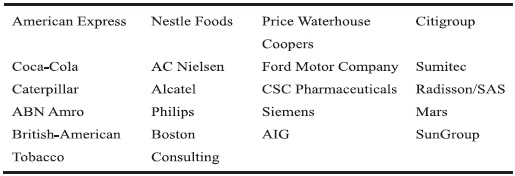
FIGURE 2 - Characteristics of respondents
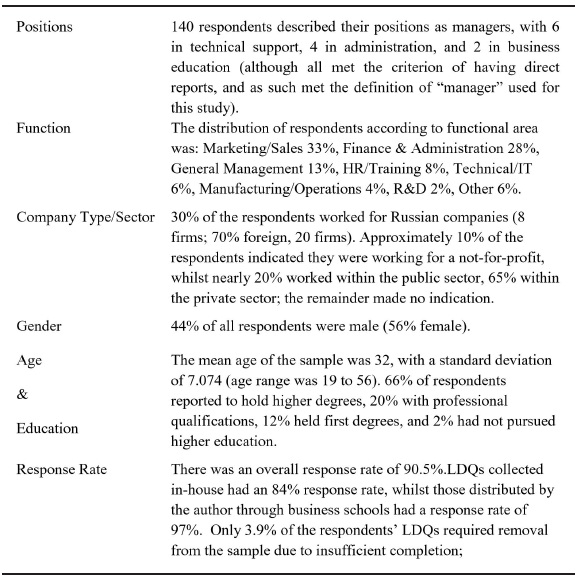
Once the data had been fully collected, the author proceeded with the initial stage of data analysis
Data Analysis and Results
Figure 3 summarizes the results of the hypothesis testing, followed by a discussion of the findings.
FIGURE 3 - Summary of hypothesis testing
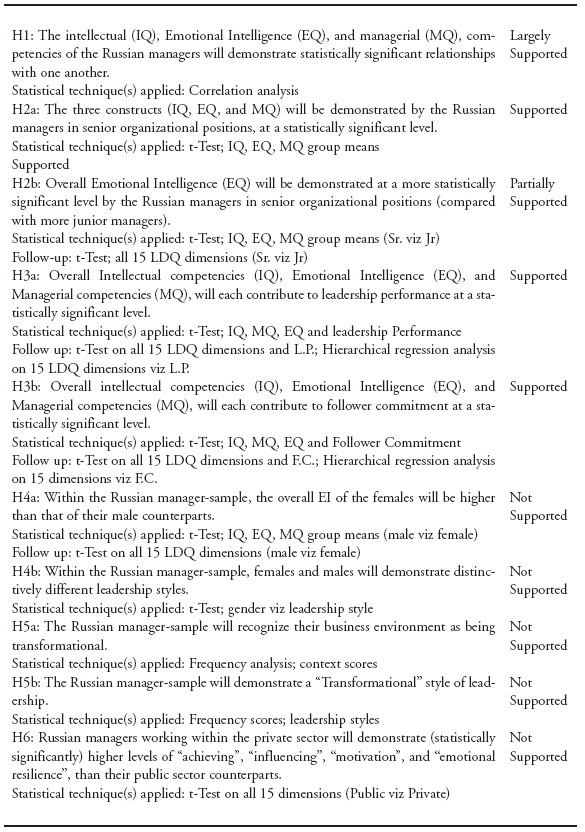
Prior to hypothesis testing, the researcher applied statistical measures of distribution to all 15 LDQ dimensions, finding both Skewness and Kurtosis to be well within acceptable ranges e.g., Skewness (+1 to -1) and Kurtosis (+3 to -3); (Hair et al., 2003). The researcher applied a conservative confidence cut-off value of 95% (sig = .05). Value inflation factors and tolerance were in line with acceptable norms precluding the possibility of inaccurate results due to multicollinearity between variables i.e., VIF < +5 and tolerance > .10.
With the exception of intuitiveness, the three constructs (IQ), (EQ), and (MQ) were highly correlated with one another for the Russian manager-sample. Whilst IQ, EQ, and MQ all contributed significantly to managers at more strategic levels of their organizations, early literature was further supported by EQ contributing more to senior executives than to their junior counterparts; vision, achieving, motivation, communication, and intuitiveness demonstrated the most significant difference between the senior and junior management groups.
Moreover, the constructs of IQ, EQ, and MQ each contributed to leadership performance and follower commitment at statistically significant levels, with: vision, perspective, self-awareness, emotional resilience, influencing, motivation, managing resources, communication, empowering, developing, and achieving, demonstrating the strongest relationships with leader performance, and: critical analysis, perspective, self awareness, sensitivity, managing resources, communication, empowering, and developing, showing significant correlations with follower commitment. Furthermore, communication was predictive of leader performance, whilst sensitivity and communication were revealed as being predictive of follower commitment.
This investigation failed to support previous claims that female managers have significantly higher levels of EQ than their male colleagues, or even that male and female managers demonstrate diverse styles of leadership. No significant differences were found between the Russian men and women participating in this research and in any of the 15 LDQ dimensions. Finally, earlier assertions that significant differences exist between the competencies of private and public sector managers were not supported by the data. The hypothesis testing has added considerable statistical support for several of the hypotheses (if only partially), in addition to revealing inference for the overall research question.
DISCUSSION AND CONCLUSIONS
The practical motivation for this study was to offer organizations operating within the Russian Federation leadership development expertise to fill the growing void identified by practitioners and scholars alike, through a comparative-cultural study of Russian managers contrasted with Dulewicz and Higgs UK norms group (see Tables 2 and 3 below).
TABLE 2 - UK/Russia comparison of LDQ group means
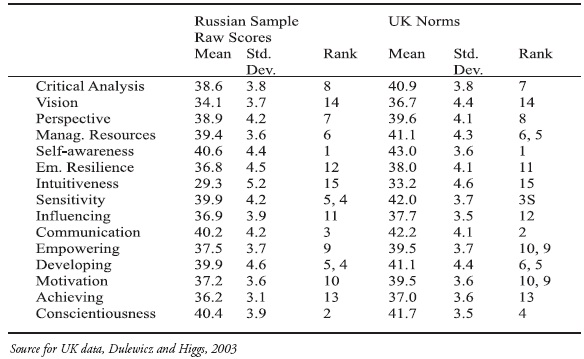
TABLE 3 - LDQ comparative culture findings (highlighting similarities and differences)
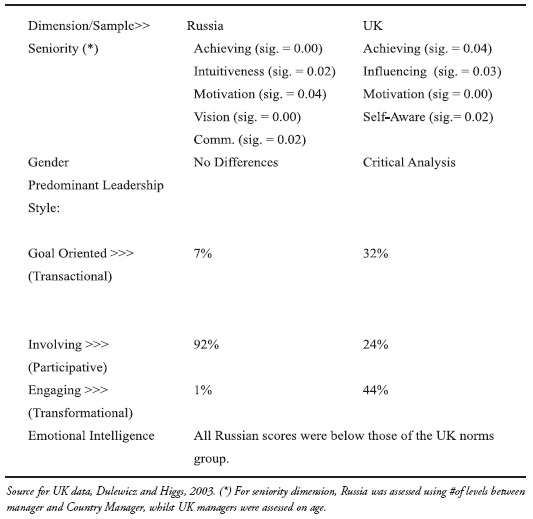
Prima facie, one notices the similarities between the Russian and UK profiles, which is verified when the means of both samples are rank-ordered (highest to lowest; see table 5.1a). The rank-ordering reveals less of a difference than the original straight relationship analysis might imply. Nonetheless, within the context of leadership style, significant differences reemerge (see table 5.1b). Table 5.1b offers a complete summary of the researchers Russian sample as compared with the UK norms; highlighting similarities and differences.
CONTRIBUTION TO THEORY AND PRACTICE
This comparative-cultural investigation contributes to several bodies of literature, including:
•International Leadership – This study identified Russian leadership profiles, a dominant leadership style, competencies that contributed to, and were predictive of, leader performance/follower commitment.
•Management Studies – A comparison of managers competencies across organizational levels. Duties, roles, and responsibilities vary across the organizational hierarchy, with more senior mangers usually oriented towards the long-term strategic ends of the business (including vision development; Shamir, 1995), middle managers being involved with means, and line managers and supervisors overseeing operations. •International Business/Comparative Cultural Studies – This study targeted respondents from MNCs/large companies due to the fact that they operate internationally as drivers of globalization, and as such have the greatest need for understanding and developing their own multi-cultural managers (Harris et al., 1996).
•Emotional Intelligence/Psychology – EI is a relatively new discipline that has quickly established itself, as it continues receiving a great deal of attention by researchers, not the least of which has to do with EIs possible relationship to other concepts such as self-actualization; a further question being how/why these concepts might differ across cultures.
•Human Resource Management – Human resources have increased in their importance within organizations, and it has been asserted that the only sustainable competitive advantage organizations will have in the future will be the value added by their employees, and most notably their organizational leaders (Kotter, 1996). Designing effective leadership development programs to foster such executives has been described as the biggest challenge that looms in the new millennium for HR managers (Javidan et al., 2006, p. 85).
•Gender Studies - It has been recognized that much leadership literature has focused on male leaders within Western companies(e.g., Alimo-Metcalfe, 1995), whilst there have been no rigorous Western studies involving the comparison of male and female managers as peers, or at different organizational levels, within the Russian Federation.
•Organizational Behavior – Few organizations within this era of global competition are successful without adequate leadership (Den Hartog et al., 1999). Furthermore, it has been argued that matching leadership styles with operating contexts is a critical factor contributing to the ultimate success (or failure) of organizations (e.g., Fiedler, 1967; Bass, 1999).
•Sociology – Hofstede (1980; 1993) maintained that management reflects its greater culture/society. Therefore, by taking a contemporary look at Russian management/leadership, one can gain critical insights into Russian society, social norms, etc.
POSSIBLE LIMITATIONS
There are always limitations to research in the sense that no research is perfect. Yet research is central to developing our knowledge and understanding of the business world, and as such, even flawed and limited investigations offer valuable insights and contributions to both theory and practice (McGrath, 1982).
Authors have identified possible flaws related to self-report survey-based research – the most problematic usually being attributed to common methods variance (CMV). In an attempt to control against possible common methods bias, the author applied Harmans one-factor test (recommended by Podsakoff and Organ, 1986). The results demonstrated that no single factor accounted for more than the acceptable limit of variance (>.5), thereby indicating that CMV should not pose a threat to the results.
The LDQ has undergone rigorous testing for accuracy (validity) and consistency (reliability). For extensive coverage of the LDQs validity and reliability refer to the publications of Dulewicz and Higgs (2003; 2004). Construct validity was demonstrated through pilot tests and extensive concept mapping exercises; this approach of concept mapping is widely acknowledged and advocated for creating a structured visual display of the domain of a concept (Trochim, 1989).
Dulewicz and Higgs (2003) report alpha coefficients ranging between .65 - .82; (.6 -.8) as denoting good – very good levels of reliability (e.g., Hair et al., 2003). Nonetheless, no measure is reliable and valid," per se ; only the inferences drawn from using the measure (Trochim, 1989).
FURTHER RESEARCH AND CONCLUSION
Broadly speaking, the most valuable contribution of this study may well be its exploratory nature, creating a theoretical platform for research; e.g. a longitudinal study of Russian organizational leadership could be of value in identifying possible changes and trends as compared with other nations; correlation studies including such instruments as the Spony Profiling Model (SPN), developed at Cranfield School of Management, measuring the impact of organizational culture on managers perspectives and behaviors; specific studies focusing on women as leaders, managers, and entrepreneurs are also greatly needed – to fill a growing deficit within the Russian management literature.
REFERENCES
ALIMO-METCALFE, B. (1995), «An investigation of female and male constructs of leadership». Women in Management Review. MCB, Bradford.
BASS, B. M. (1985), Leadership and Performance Beyond Expectations . Free Press, New York. [ Links ]
BASS, B. M. (1999), « Two decades of research and development in transformational leadership». European Journal of Work and Organizational Psychology, 8, 1, pp. 9-32.
BASS, B. M. & Avolio, B. J. (1995), The Multifactor Lead er ship Questionnaire . Mind Garden, Palo Alto, CA.
BLAKE, R.R. & Mouton, J. S. (1964), The Managerial Grid . Gulf Publishing, Houston.
BURNS, J. M. (1978), Leadership . Harper and Row, New York.
CONGER, J. A. & Kanungo, R. (1987), « Toward a behavioral theory of charismatic leadership in organizational settings». Academy of Management Review, 12, pp. 637-647.
(CPC)/RAND CORP. Report (1994), «Developing the global work-force». March.
DEN HARTOG, D. N.; HOUSE, R. J.; HANGES, P.J.; RUIZ-QUINTANILLA, S. A. & DORFMAN, P.W. (1999), «Culture-specific and cross-culturally generalizable implicit leadership theories: are the attributes of charismatic/transformational leadership universally endorsed?» Leadership Quarterly, 10, pp. 219-256.
DULEWICZ, V. & HIGGS, M. (2003), «Design of a New Instrument to Assess Leadership Dimensions and Styles». Henley Working Paper Series HWP2003/11.
DULEWICZ, V. & HIGGS, M. (2004), «Assessing Leadership Styles and Organizational Context». Unpublished Working Paper. Henley Management College.
FIEDLER, F. (1964), «A contingency model of leadership effectiveness». In L. Berkowitz (Ed.), Advances in Experimental Social Psychology . Academic Press, New York, pp. 149-190 .
FIEDLER, F. (1967), « Theory of leadership effectiveness». In N. Emler and T. Cook. (2000), Moral Integrity in Leadership. Personality Psychology in the Workplace. American Psychological Association, Washington, DC.
FLEISHMAN, E.A. (1953), «The description of supervisory behavior». Personnel Psychology, 37, pp. 1-6.
GOLEMAN, D. (1995), Emotional Intelligence . Bantam Books, New York.
GOLEMAN, D. (1998), Working with Emotional Intelligence. Bloomsbury Publishing, London.
GOLEMAN, D.; BOYATZIS, R. & MCKEE, A. (2001), «Primal leadership». Harvard Business Review, pp. 43-51, Dezember.
GRAEN, G. (2006), «In the eye of the beholder: cross-cultural lessons in leadership from project GLOBE». Academy of Management Perspectives, 20, 11, pp. 95-101.
GRATCHEV, M.V.; ROGOVSKY, N.G. & RAKITSKI, B.V. (2001), «Leadership and Culture In Russia: The Case of Transitional (Sic) Economy». Unpublished Conference Paper, Institute of World Economy and International Relations, Moscow.
HAIR, J. F.; BABIN, B.; MONEY, A. H. & Samouel, P. (2003), Essentials of Business Research Methods . John Wiley and Sons, Danvers, MA.
HARRIS, P. & MORAN, R. (1996), Managing Cultural Differences . (4th ed.), Gulf Publishing Company, Houston, Texas.
HOFSTEDE, G. (1980), Cultures Consequences: International Differences in Work-Related Values . Sage Publications, Beverly Hills, CA.
HOFSTEDE, G. (1993), «Cultural constraints in management theories». Academy of Management Executive, 7, 1, pp. 81-94.
HOUSE, R. J. (1977), «A 1976 theory of charismatic leadership». In J.G. Hunt and L.L. Larson (Eds.), Leadership: The Cutting Edge . Southern Illinois University Press, Carbondale, pp. 189-207.
HOUSE, R.J.; JAVIDAN, M. & Dorfman, P. (2001), «Project GLOBE: an introduction». Applied Psychology: An International Review, 50, 4, pp. 489-505.
JAVIDAN, M.; DORFMAN, P.; SULLY DE LUQUE, M. & HOUSE, R. J. (2006), «In the eye of the beholder: cross-cultural lessons in leadership from project GLOBE». Academy of Management Perspectives, 20, 1, pp. 67-89.
KATZ, D. & KAHN, R.L. (1952), «Some recent findings in human-relations research in industry». In E. Swanson; T. Newcomb and E. Hartley (Eds.), Readings in Social Psychology. Holt, New York, pp. 650-665.
KOTTER, J. P. (1996). Leading Change . Harvard Business School Press, Boston, MA.
KREJCIE, R.V. & MORGAN, D.W. (1970), « Determining sample size for research activities». Educational and Psychological Measurement, 30, pp. 607-610.
MACKIEWICZ, A. & DANIELS, N. (1994), «The Successful Corporation of the Year 2000». Economist Intelligence Unit. Research Report. New York.
MCCLELLAND, D.C. (1973), «Testing for competency rather than for intelligence». American Psychologist, pp. 1-24.
MCGRATH, J.E. (1982), «Dilemmatics: the study of research choices and dilemmas». In J.E. McGrath, Judgment Calls and Research . Sage Publications, Beverly Hills, CA.
PODSAKOFF, P. M. & ORGAN, D.W. (1986), «Self-reports in organizational research: problems and prospects». Journal of Management, 12, 4, pp. 531-543.
PUFFER, S. M.; SHEKSHNIA, S. V. & MCCARTHY, D. J. (2007), « Leadership development in Russia ». In T. Lidokhover (Ed.), Human Resources Management in Russia. Ashgate, Aldershot.
SALOVEY, P. & MAYER, J. (1990), «Emotional intelligence». Imagination, Cognition, and Personality, 9, pp.185-211.
SHAMIR, B. (1995), «Social distance and charisma: theoretical notes and an explanatory study». Leadership Quarterly, 6, pp. 19-47.
SHEKSHNIA, S. (1998), «Western MNCs human resource practices in Russia». European Management Journal. 12, 3, pp. 298-305.
TROCHIM, W. M. (1989), «An introduction to concept mapping for planning and evaluation». Evaluation and Program Planning, 12, pp. 1-16.
WEBER, M. (1947), The Theory of Social and Economic Organizations . Translated by T. Parsons. Free Press, New York.
WREN, J. D. (2005), «Leader Competencies, Style and Activities Contributing to Successful Change in the Royal Air Force». MBA Thesis. Henley Management College.
YOUNG, M. (2004), «Command, Leadership and Management Competencies: Predicting Superior Performance in The Royal Navy. DBA Thesis. Henley Management College/Brunel University.













